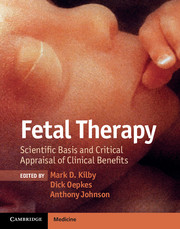Book contents
- Frontmatter
- Contents
- Contributors
- Foreword
- Preface
- Section 1 General principles
- Chapter1 The rationale for fetal therapy
- Chapter 2 Insights into pathogenesis of adult cardiovascular disease from fetal animal studies
- Chapter 3 Human embryology
- Chapter 4 Ethics of fetal therapy
- Chapter 5 Fetal therapy choices
- Section 2 Fetal disease
- Glossary
- Index
- References
Chapter1 - The rationale for fetal therapy
from Section 1 - General principles
Published online by Cambridge University Press: 05 February 2013
- Frontmatter
- Contents
- Contributors
- Foreword
- Preface
- Section 1 General principles
- Chapter1 The rationale for fetal therapy
- Chapter 2 Insights into pathogenesis of adult cardiovascular disease from fetal animal studies
- Chapter 3 Human embryology
- Chapter 4 Ethics of fetal therapy
- Chapter 5 Fetal therapy choices
- Section 2 Fetal disease
- Glossary
- Index
- References
Summary
Introduction
From the beginning of man’s evolution, the human fetus has enjoyed a privileged environment “shielded from the eyes” of the physician. The specialty of radiography allowed for still images of the unborn baby to be obtained but invasive procedures such as intraperitoneal transfusions required injection of radio-opaque dye to localize target areas. It was though the advent of real-time ultrasound in the late 1970s that marked the true beginning of the diagnostic era of fetal medicine. Structural abnormalities could now be diagnosed in-utero.
In the book King of Hearts, author Wayne Miller tells the story of Dr. Walt Lillehei – the early pioneer of open heart surgery for congenital heart disease [1]. His first surgical failure to correct a ventricular septal defect was followed by two successes. The first patient’s mother wrote to Lillehei: “Though it is hard not to feel bitter that little Greg couldn’t have lived to rejoice with the other two, we just have to accept it as the Lord’s will and we know that his death wasn’t in vain as it has given these other two children another chance to live and no doubt many more … May God bless and guide you in the wonderful work that you are doing.”
- Type
- Chapter
- Information
- Fetal TherapyScientific Basis and Critical Appraisal of Clinical Benefits, pp. 1 - 11Publisher: Cambridge University PressPrint publication year: 2012
References
- 1
- Cited by



